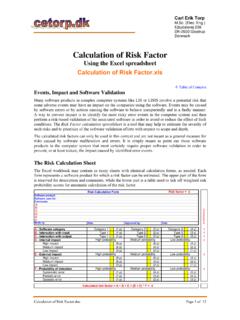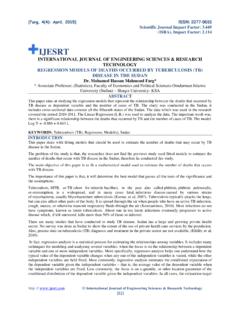Transcription of Calculation of Risk Factor - cetorp.dk
1 Carl Erik Torp (Elec. Eng.) Ejbydalsvej 239 DK-2600 Glostrup Denmark Calculation of Risk Factor Using the Excel spreadsheet Calculation of Risk Table of Contents Events, impact and Software Validation Many software products in complex computer systems like LIS or LIMS involve a potential risk that some adverse events may have an impact on the companies using the software. Events may be caused by software errors or by actions causing the software to behave unexpectedly and in a faulty manner. A way to prevent impact is to identify the most risky error events in the computer system and then perform a risk-based validation of the associated software in order to avoid or reduce the effect of fault conditions.
2 The Risk Factor Calculation spreadsheet is a tool that may help to estimate the severity of such risks and to prioritize of the software validation efforts with respect to scope and depth. The calculated risk factors can only be used in this context and are not meant as a general measure for risks caused by software malfunction and errors. It is simply meant to point out those software products in the computer system that most certainly require proper software validation in order to prevent, or at least reduce, the impact caused by identified error events. The Risk Calculation Sheet The Excel workbook may contain as many sheets with identical Calculation forms, as needed.
3 Each form represents a software product for which a risk Factor can be estimated. The upper part of the form is reserved for description and comments, while the lower part is a table used to tick off weighted risk probability scores for automatic Calculation of the risk Factor . Risk Calculation Form0 Made by: A Category 1 (1 p)Category 2 (2 p)Category 3 - Software category(4 p)0B - Interaction with inputType 1 (1 p)Type 2 (2 p)Type 3 (3 p)0C - Interaction with outputType 1 (1 p)Type 2 (2 p)Type 3 (3 p)0D -0 Internal impactHigh impact (9 p)(6 p)(4 p)Medium impact (6 p)(4 p)(2 p)Low impact (3 p)(2 p)(1 p)E - External impactHigh impact (9 p)(6 p)(4 p)Medium impact (6 p)(4 p)(2 p)Low impact0(3 p)(2 p)(1 p)F - Probability of detectionSystematic error(1 p)(4 p)(5 p)Periodic error(1 p)(3 p)(4 p)Sporadic error0(1 p)(2 p)(3 p)0 Risk Factor = Calculated risk Factor = A + B + C + (D + E) * F = A.
4 B: C: D: E: F: ConsequenceLow probabilityDate: Approved by: Date: Software product: Software used for: High probabilityMedium probabilityLow probabilityComments: Medium probabilityHigh probabilityLow probabilityHigh probabilityMedium probability Calculation of Risk Page 1 of 12 Carl Erik Torp (Elec. Eng.) Ejbydalsvej 239 DK-2600 Glostrup Denmark The calculated risk Factor (which is a number between 0 and 100) is a relative quantity that only has meaning when compared to other factors estimated on the same basis.
5 The actual risks should always be estimated using the system perspective ( estimated relative to the actual system, not a particular process in the system) since that will provide the best basis for comparison. All sheets use the same score, and each score value is obtained by reference to a similar value stored in a hidden sheet named Basis . Thus, if a basic score value is changed the Calculation on all sheets will change accordingly. All sheets are write-protected (without password) so that only the description area and the yellow tick off cells can be altered. The Template sheet is intended as a template for the Copy and function which must be used to create additional identical Risk Calculation sheets.
6 Description and comments Software product: Unique name of the software product or module being risk assessed. Software used for: Brief description of what the software product or module is used for. Comments: General notes - Estimated error event: Error occurs when .. A: Software category - Customized standard software .. B: Interaction with input - Input from operator and another module .. C: Interaction with output - Output to operator and database .. D: Internal impact - Low probability and medium impact because .. E: External impact - High probability and medium impact because .. F: Probability of detection - The systematic error is detected immediately due to.
7 Made by: Date: Approved by: Date: A: Software Category The software category is divided into three levels as defined in the table below. Most software modules in a LIMS system belong to Category 2 while software products, which are customized or developed by the users themselves (such as spreadsheets) belong to Category 3. Operative systems and MS Office packages are normally Category 1. Category Description Category 1 * Standard Software Packages Commercial off-the-shelf (OTS) software packages.
8 Examples: Excel spreadsheets and PC-controlled instruments with minimum configuration. Category 2 Custom Configurable Software Packages Typical features of these systems are that they permit users to develop their own applications by configuring predefined software modules and by develop-ing new application software modules. Examples: Human Machine Interfaces (HMI), Supervisory Control and Data Acquisition (SCADA), Laboratory Automation Systems (LAS), Material Requirements Planning Systems (MRP) and Laboratory Information Manufacturing Systems (LIMS). Category 3 * Custom Built Software Includes any application, off-the-shelf software or other software products that are modified or developed according to custom requirements.
9 This also applies to Standard Software Packages used to develop custom applications and to programming languages. * Complex spreadsheets with macros belong to Category 3. Calculation of Risk Page 2 of 12 Carl Erik Torp (Elec. Eng.) Ejbydalsvej 239 DK-2600 Glostrup Denmark B & C: Interaction with Input & Output Interaction in this context indicates that there is a risk whenever data are transferred to (output) or from (input) other software. data may be received incorrectly or may be corrupted, or the receiver may respond inappropriately or unexpectedly. It should also be taken into account if data can be re-transmitted in case of errors and that the operator may be part of the risk, even if the data transfer is entirely controlled by software.
10 It is important to make a distinction between input and output. To make the estimate easier, the risks are divided into three types based on the amount and importance of the transferred data. Interaction with Input & output Type 1 Very few data and/or insignificant contents Low risk Type 2 Certain amount of data and/or rather important contents Medium risk Type 3 Large amount of data and/or very critical contents High risk D & E: Internal & External impact impact is a measure of how severe and harmful a possible software error event is for the company. This indefinable quantity cannot stand alone, but has to be combined with the probability of the event to occur.

